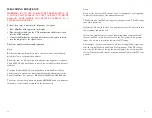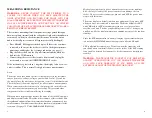
8
MEASURING CAPACITANCE
Follow these steps to measure capacitance.
• Press
DIODE
/
CAP
. nF appears on the display.
• Plug the red test lead into the -||- terminal and plug the black test lead
into the COM terminal.
• Fully discharge the capacitor.
• If you are checking an electrolytic capacitor, attach the capacitor's +
side to the red probe or plug into the + OHMS/DIODE/CAP socket.
Then, attach the capacitor's
–
side to the black probe or to the
–
OHMS/DIODE/CAP socket.
For other capacitor types, connect the probes to the capacitors leads.
Polarity does not affect the measurement of non-electrolytic capacitors.
Or, install the capacitor in the OHMS/DIODE/CAP socket. Observe
polarity (+ and
–
) when you measure electrolytic capacitors.
Notes:
If you use the test probes, do not touch the probes while you are check-
ing the capacitor. Your body's capacitance can affect the measurement.
An electrolytic capacitor's measured capacitance changes depending
upon the voltage applied to the capacitor. Because this meter cannot
use rated voltages to set the electrolyte, it cannot measure the absolute
capacitance value.
The lowest capacitance ranges might be offset by the meter's and test
leads' capacitance. When you measure very small-value capacitors, we
suggest you use the relative function to subtract the internal capaci-
tance from the measurements. (See pages 14-15,
U
SING
THE
H
OLD
AND
R
ELATIVE
F
UNCTIONS
.
)
9
CHECKING DIODES
This function lets you check diodes and other semiconductors for opens
and shorts. It also lets you determine the forward voltage for diodes.
You can use this function when you need to match diodes.
• Press
DIODE
/
CAP
so that
–
|
>
|
–
appears in the display.
• Plug the red test lead into the
–
|
>
|
–
terminal and the black test lead
into the COM terminal.
• Remove power from the circuit under test.
• Connect the probes to the component you want to check or plug the
component into the OHMS/DIODE/CAP socket. If the diode is
banded, connect the banded end to the black test probe or the
OHMS/DIODE/CAP socket. Then, note the display.
If the display shows a value, for example, 0.2 for a germanium diode or
0.5 for a silicon diode, reverse the diode. If the meter indicates an over-
range, the diode is good. The displayed number is the diode's actual
forward voltage (Up to 2.5 volts).
If the display indicates an overange condition
(see page 3)
, reverse the
polarity of the connection.
If the display shows a value, the device is good. The displayed value is
the component's actual forward voltage (up to 2.5 volts).
If the display still indicates an overrange condition, the device is open.
If the display shows a value both before and after you reverse polarity,
the device is shorted or the meter's .063-amp fuse is blown.
When you connect the diode to the meter and the meter displays the
device's forward voltage, the red test lead or + OHMS/DIODE/CAP
socket is connected to the diode's anode, and the black lead or
–
OHMS/DIODE/CAP socket is connected to the diode's cathode.
This meter supplies enough forward voltage to light most LEDs. How-
ever, if the LED's forward voltage is greater than 2.5 volts, the meter
incorrectly indicates that the device is open.
The bar graph shows a maximum reading of 24, even during an overrange.








